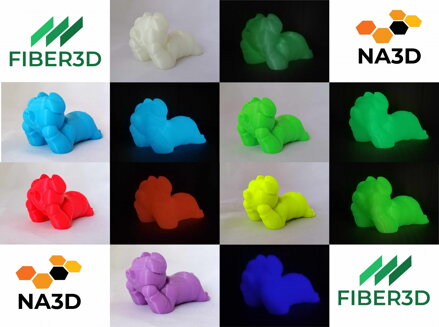Availability: order-samples will be available within 1-7 days of ordering.
Warning: samples are intended for immediate use.
Quality printing material brand FIBER3D
PLA Material Shining in the dark is suitable for use in 3D printers as it is very strong. It does not exclude chemical odor when printing. The PLA material is biodegradable, it is made of renewable natural resources. In the case of printing large components, it will help you to print it more easily PLA.
Material description : PLA, Polylactic acid, polylremic acid is a bioplastic made of corn starch. It has similar properties to plastics that are made of oil. PLA is much more gentle on nature than ABS, for example, is harmless and degradable in condenses. It can be dissolved with tetrahydrofurene, any long -term exposure to acetone can cause the surface to etch. The disadvantage is lower temperature resistance. Compared to ABS, the material strength is higher, the material is better printable. PLA can be actively cooled during printing, it does not need a heated pad.
The PLA processing temperature is 190 - 220 ° C.
Print: It is therefore recommended to cool the print, such as water cooling during manual grinding. The material can also be sprayed first with a filler (used in modeling), then grind it, spray and grind. Repeat these activities until the print is perfectly smooth for you. The resulting model can also be sprayed with paint. It is also possible to put it in the "tissue" together with shells, stones, remnants of filaments or pieces of prints.
Storage: In poor storage in a humid environment, it absorbs moisture, which manifests itself as bubbles on the surface. Protect from heat.
Main advantages of material:
- shines in the dark
- small shrinking in cooling - no heated pad or chamber
- good print quality even when printing at high speed
- soluble in sodium hydroxide
- biodegradable material
Supplied in 6 shades.
10 meter sample (+-1 meter-packed manually)
Note: The intensity of the luminous intensity in the dark depends on the lighting.
More from category
Additional information
| Category: | Samples, swatches |
| Color: | purple, yellow, green, blue, red, white, svítící ve tmě |
| Weight: | vzorek |
| Average: | 1,75 mm |
| Diameter: | ± 0,02 mm |
| Bed temperature: | 0 - 60° C |
| Nozzle temperature: | 190 - 220° C |

2,05 €
1,69 € excl. VAT










